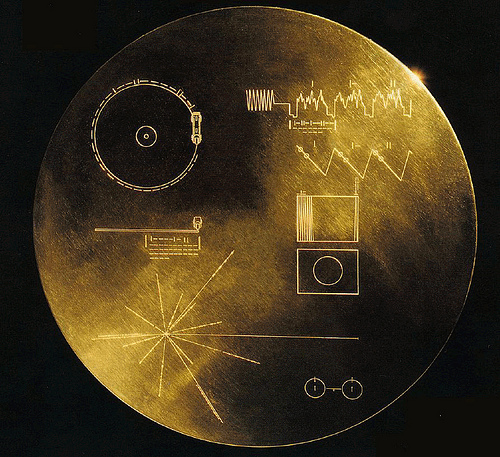
 )
)On a trip to the National Air & Space Museum with my son this weekend, I had a chance to look at a copy of one of the records that was sent on the Voyager space probe. The photo on the right shows the top of the record, which is meant to provide details on how to play it and how to decode the images stored on it. (We sent both music and images intended to represent the ecological and cultural diversity of Earth.) These instructions also include some basic science and the coordinates of our planet. It is believed any society sufficiently advanced to retrieve the probe and records from space will be able to decipher this information.
Now, I’ll be honest. Even though I have studied some math and physics and computer science here on Earth, it wasn’t immediately obvious what was meant by all of these diagrams and images and notation. Granted, I didn’t have long to look at the record before it was time to give the next museum patron a turn. Our galactic neighbors on the other hand will have an unlimited amount of time to puzzle it out. Also, I am not myself an expert in any of the relevant fields; there may be features that would jump out immediately to someone who deals with pulsars or atomic physics on a daily basis. So I’m not critiquing the choices that were made, rather trying to highlight just how challenging the problem is.
It’s difficult to completely step out of your own culture and perspective, especially when you can’t interact with someone who represents the outside you are trying to understand. So I can’t help but wonder if the details are more idiosyncratically human and less universal, despite the best efforts of many very intelligent and thoughtful people. Communication is so dependent on shared context. Stars and the elements of which they are composed seem like the kind of context we can count of sharing with everyone in our galaxy. Yet we may still think and talk about them very differently.
On the same trip but not at the museum, I came across the assertion that God could not create a world in which 2 + 2 does not equal 4. In its own way, that statement is attempting something similar to the Voyager records: finding and expressing universal truth. Or necessary truth, as the author put it, the kind of truth that doesn’t depend on context or circumstance. I appreciate the underlying point, but I can’t help but wonder if such a claim sells God’s imagination short. How do we know there is no such possible universe? How could we begin to imagine one?
Even in this universe, math can get more interesting than one might realize if one sticks to everyday arithmetic. Complex numbers cannot be ordered uniquely the way real numbers can; matrices and quaternions (a further extrapolation from complex numbers) do not have the property that a x b = b x a. In fact, one can even do arithmetic on finite groups with a limited set of numbers, such that 2 + 2 might be 0 or 1, depending on the group.
Thus truly universal truths can be more elusive than they seem. As a Christian, I ultimately look to God for such truth. And I am very grateful that he chose to build a context for communicating with us by sharing in our experience as the man Jesus of Nazareth. I cannot imagine how we might be able to learn about him if he hadn’t reached out to show us the way, and indeed to become the Way.
Want to explore more about communication and its relationship to math? Join the conversation on Chapter 1 of Faith across the Multiverse.
Andy has worn many hats in his life. He knows this is a dreadfully clichéd notion, but since it is also literally true he uses it anyway. Among his current metaphorical hats: husband of one wife, father of two teenagers, reader of science fiction and science fact, enthusiast of contemporary symphonic music, and chief science officer. Previous metaphorical hats include: comp bio postdoc, molecular biology grad student, InterVarsity chapter president (that one came with a literal hat), music store clerk, house painter, and mosquito trapper. Among his more unique literal hats: British bobby, captain’s hats (of varying levels of authenticity) of several specific vessels, a deerstalker from 221B Baker St, and a railroad engineer’s cap. His monthly Science in Review is drawn from his weekly Science Corner posts — Wednesdays, 8am (Eastern) on the Emerging Scholars Network Blog. His book Faith across the Multiverse is available from Hendrickson.

Leave a Reply